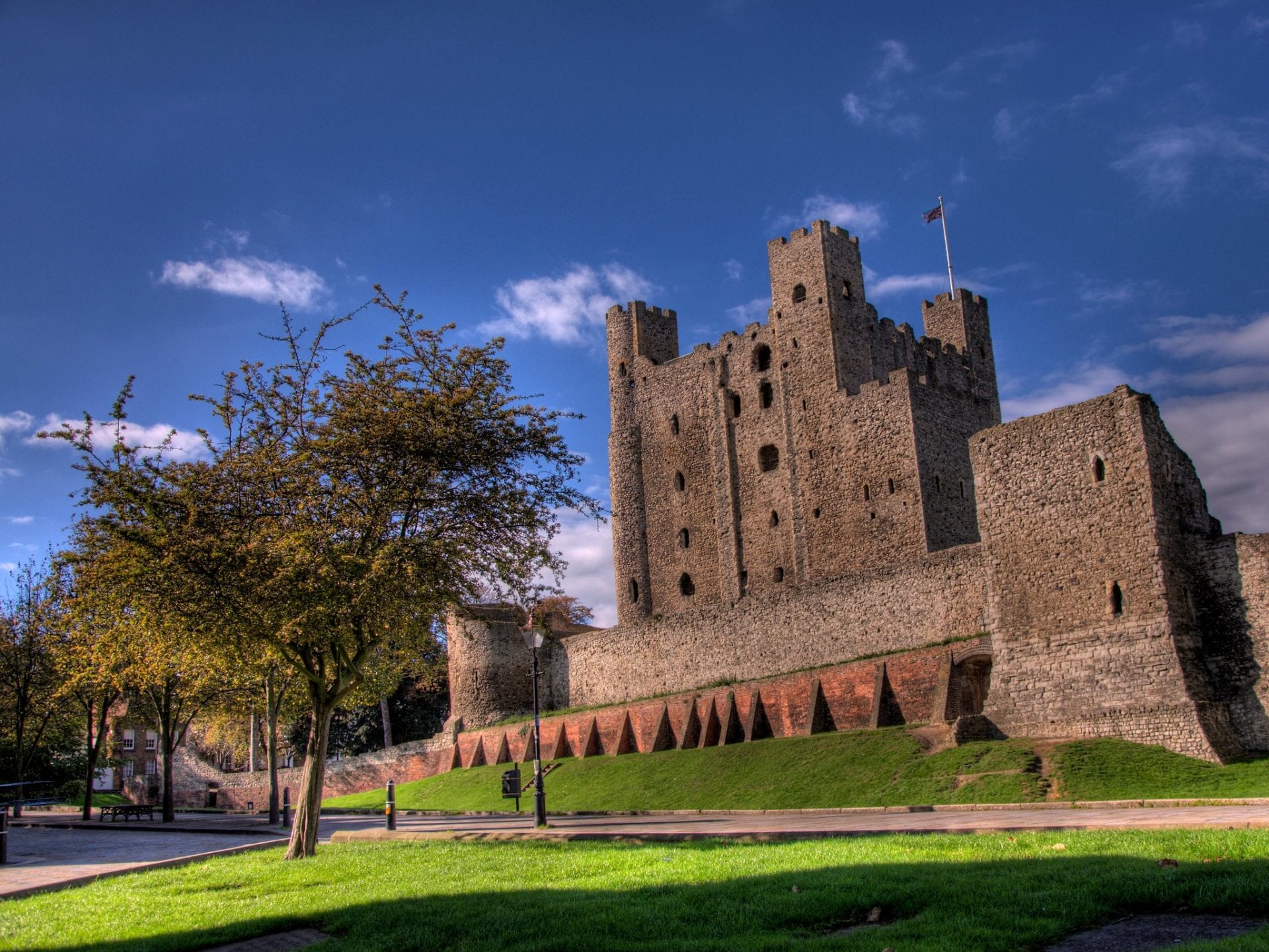Rochester Castle is an English castle on the banks of the River Medway in Rochester, England, that during the first Baron’s War was captured by baronial forces and stood against King John in a bloody siege.
An early castle was constructed after the Norman conquest, in which the Domesday Book of AD 1086 records a mark of compensation for the land to the Bishop of Rochester to build a castle that supported 60 knights’ fees.
After the death of William the Conqueror in 1087, his territories were divided between his two sons, Robert, the elder, who inherited the title of Duke of Normandy, and William Rufus who became King of England. Norman barons objected to dividing Normandy and England, leading to an uprising where Rochester Castle became the headquarters for supporting Robert.
In 1088, Rochester was placed under siege by William’s forces and the historical city was encircled by two siege castles, resulting in the garrison surrendering and the abandonment of Rochester Castle.
William commissioned Gundulf, Bishop of Rochester to rebuild the castle’s defences in stone, reinforced in 1127 by the Archbishop of Canterbury, William de Corbeil, who constructed the Great Keep, described by contemporaries as ‘outstanding’ and ‘noble’.
During the reign of King John (1199–1216), English forces in Normandy were defeated by King Philip II of France, threatening England with the possibility of French invasion and the collapse of the Angevin Empire.
John invested in strengthening the existing castles of the south east, in which Rochester was strategically important to guard the River Medway and the approach to London on Watling Street.
The loss of the ancestral lands in France, increased taxation on the English Baron’s (many of whom owed money to the Crown), and the rule by successive English kings using the principle of vis et voluntas, or “force and will”, led to the Barons organising resistance to John’s rule.
In 1215, John met with the Barons at Runnymede on the south bank of the River Thames and sealed his agreement to the terms negotiated from the ‘Articles of the Barons’ that became known as the Magna Carta. The royal charter promised the protection of church rights, protection for the barons from illegal imprisonment, access to swift justice, and limitations on feudal payments to the Crown.

Neither the Barons, nor John abided by the article’s rules, and that same year the Pope declared the charter to be “not only shameful and demeaning, but also illegal and unjust”, ultimately leading to open war between the barons and the king.
Fearing that Rochester Castle would give John a powerbase in the southeast, a group of rebels under the command of William d’Aubigny went to seize the castle, but found that the castle’s constable, Reginald de Cornhill had switched allegiance away from the crown and opened the gates. Chroniclers’ figures suggest that d’Aubigny’s defending force ranged from 95 to 140 knights, supported by crossbowmen, and soldiers.
John at the time was also in the south-east recruiting mercenaries for his army, but now found that his direct route to London was blocked. John and his army arrived in the October of 1215 and stormed the city, placing the castle under siege.
Contemporary accounts by the Barnwell Chronicle, a thirteenth-century Latin chronicle records that the castle was attacked day and night by five siege engines hurling a barrage of stones, and missiles from smaller bows and crossbows.

When the castle’s outer walls were eventually breached, the defenders retreated to the relative safety of the Great Keep. Unable to bring down the keep’s walls with siege engines, John resorted to mining a tunnel and ordered Hugh de Burgh to “send to us with all speed by day and night forty of the fattest pigs of the sort least good for eating to bring fire beneath the tower” causing one corner of the keep to collapse.
Still the rebels remained defiant and barricaded themselves behind the stone partition or cross-wall in the keep, which the Barnwell chronicler remarked “for such was the structure of the stronghold that a very strong wall separated the half that had fallen from the other”.
Over the weeks that followed, starvation and malnutrition forced some of the defenders to leave the safety of the keep, with some sources recording John ordering that their hands and feet were to be amputated in retribution.
In November 1215, the defenders finally surrendered and were either imprisoned or sent to royal castles such as Corfe for confinement, with a single crossbowman who had previously been in John’s service hanged.
Of the siege, the Barnwell chronicler wrote “No one alive can remember a siege so fiercely pressed and so manfully resisted” and that, after it, “There were few who would put their trust in castles”.
In the following year, John contracted dysentery whilst campaigning against the rebels and died on the night of 18/19th October. His body was brought to Worcester Cathedral and was buried in front of the altar of St Wulfstan where he now remains.
Header Image Credit : Brian Fuller – CC BY-ND 2.0





